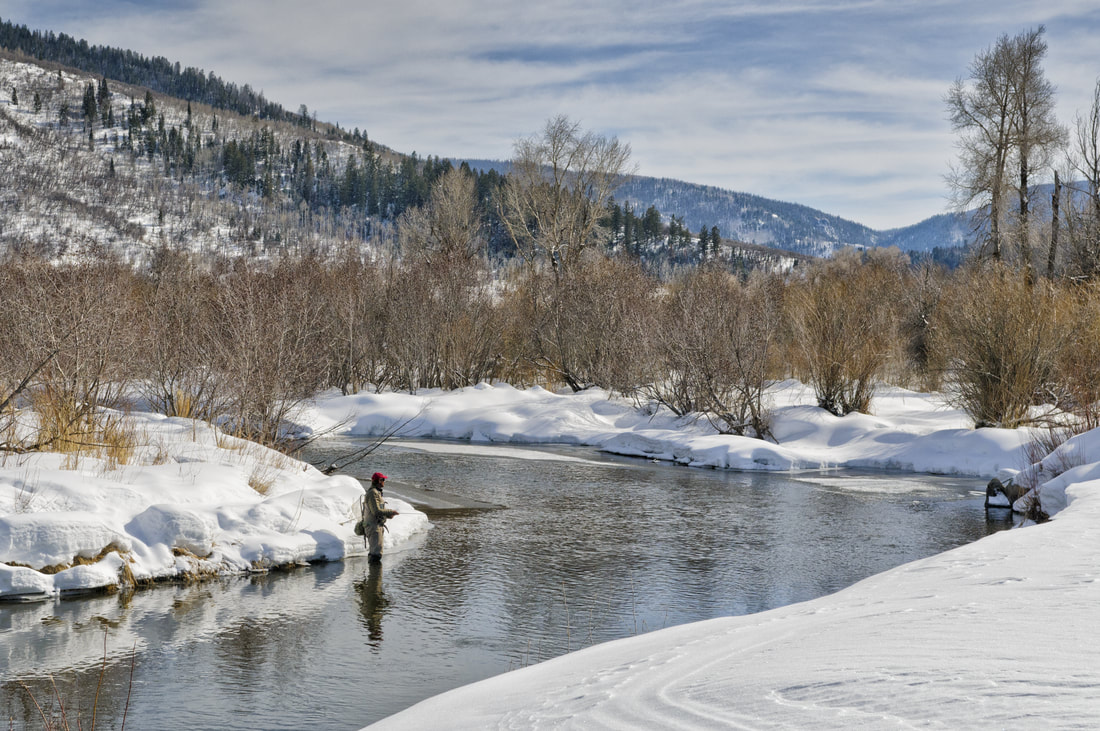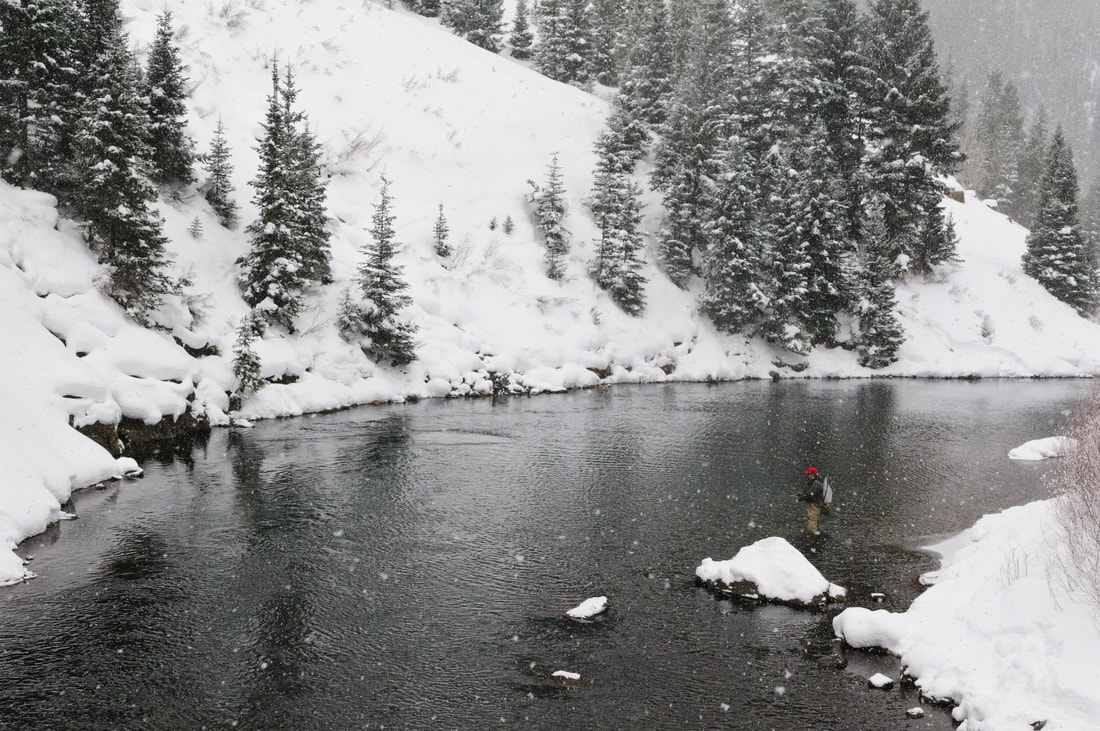Tips to Catch Winter Trout
Strange as it might sound—winter is one of my favorite times of the year to fish. Anglers willing to battle the elements can usually find a little solitude and a few feeding fish on almost any winter outing. Winter fishing is oftentimes the most technical fishing of the year. Fly-fishers need to bring their A game as low, clear flows, ice-cold water, sporadic hatches, and lethargic trout all add to the challenge and complexity of the winter season. Add extreme air temperatures and nasty weather to the equation and things get real interesting! Here’s a few tips to increase your overall enjoyment and productivity during the winter.

Targeting the soft-watermargins is key tosuccess during the winter months. Stay away from fastrifles and runs as they are typically void of fish.
Finding winter trout: Tailwaters are your best option during the winter months as freestones (unregulated streams) are typically jammed with ice. Even during the coldest months of the year, tailraces remain ice-free for several miles below the dam. Between November and March, trout reside in the slow runs and deep pools. These areas provide trout with the largest quantity of food, while expending the least amount energy. Stay away from fast riffles and runs as these areas typically have fewer fish.
Window of opportunity: The best fishing is between 11 a.m. and 3 p.m. If the water temperature is below 40 degrees, chances are pretty good you’ll have difficulty finding feeding trout. Oftentimes the best midge emergences occur mid to late afternoon when the water has warmed up a few degrees. There is no need to get to the river early—it’s simply a waist of time!
Forget the Forecast: Some of the best fishing occurs during inclement weather. I’ve experienced phenomenal dry fishing in a snowstorm when midges and blue-winged olives blanket the water. The high humidity stalls the development of the aquatic insects keeping them on the water longer in comparison to bright and sunny days.
Downsize your tippet: 6 and 7X tippets are mandatory for winter anglers. I recommend using 6X fluorocarbon for nymph-fishing and 7X monofilament for dry fly fishing. Make sure you carry an extra spool of each in your vest or waistpack, as running out tippet at the most inopportune time can affect the outcome of your day.
Think simple, sparse, and most importantly small: The bulk of a trout’s diet during the winter is midges. Familiarize yourself with the midge lifecycle (larva, pupa, and adult) as you’ll need to regularly imitate the various stages of their development for the next several months. Oftentimes, the difference between catching fish and not catching fish, is tying on a size 24 midge imitation instead of a 22. When in doubt—err on the small side!

Battlingthe elements is part of winter fishing. Anglers willing to do so, reap the benefits of some nice fish and solitude.
Use a yarn strike indicator: The “takes” during the winter are extremely subtle and easily missed with bobber-type strike indicators. A small yarn strike indicator is the most sensitive, especially in slow runs and pools where trout have a long time to inspect your artificial offering. I recommend using a neutral or drab-colored strike indicator to avoid spooking fish. Adjust the depth of your strike indicator frequently, keeping it 1½ to 2 times the depth of the substrate.
Adjust your weight: The old cliché, “The difference between a good angler and a great angler is one split shot”, is not far from the truth! All kidding aside—make sure you adjust your weight regularly, keeping your flies in the correct feeding zone. I begin with a size 6 split shot; then use JP’s Nymphing Mud (a moldable tungsten putty) over it to make adjustments. Fishing larva requires anglers to dredge their imitations along the substrate where their great concentrations are found. Pupae on the other hand, should be fished mid-column. Observation goes a long way here. Pay close attention to where the trout are positioned in the water column and make the necessary adjustments.
Top winter flies: I recommend carrying a thorough assortment of pale-olive and red midge larva in sizes 20-22. A Mercury Blood Midge is one of my go-to patterns during the winter. I typically use the Mercury Blood Midge as my lead fly (attractor) and trail one or two pupae behind it. Check your local regulations for specifics regarding tandem rigs. Favorite pupae patterns include: size 20-26 Black Beauties, Top Secret Midges, Medallion Midges, Manhattan Midges, Jujubee Midges, and Minute Midges. You’ll need to carry a few adult midges as well. It’s hard to go wrong with a size 20-24 Griffith Gnat, Matt’s Midge, Brooks’ Sprout Midge, or a Parachute Adams.
Look for rising trout: It’s not uncommon to find trout feeding on adult midges in the slower pools and tailouts. If you really look for them, you can find rising fish 365 days a year. Long leaders (12-15 feet) are recommended to fool these discriminating surface feeders. Dry and dropper rigs are especially effective when trout are keying on pupae in the surface film. A size 22 Tungsten Bead Head Black Beauty dropped off a heavily hackled Griffith Gnat is one of my favorite rigs. Once the trout commit to the adults, snip off the dropper, and fish with the Griffith Gnat.
Dress in layers: It is important to bundle up and wear several layers of clothing when fishing in the winter. If you get wet and cold; the experience deteriorates quickly! Dressing in layers allows you to shed clothing as the temperature warms up in the afternoon. I recommend a thin liner and a pair of SmartWool socks to keep your feet warm. A base-layer is a good idea to wick moisture away from your skin, especially if you are doing any hiking. Another good recommendation is wearing fleece pants and vest over your base layer. A Gore-Tex jacket is invaluable when it comes to outerwear. Make sure you carry two pairs of gloves (one flip mitt and one half-finger) to keep your hands warm. If one set gets wet, you have a back up! A stocking hat is another essential part of your winter apparel. I typically wear a stocking hat over a ball cap to eliminate overhead glare.
Fishing in the winter is a great way to refine your tactics and techniques. There are certainly trade-offs and compromises during the winter season—but the rewards are worth the effort!
